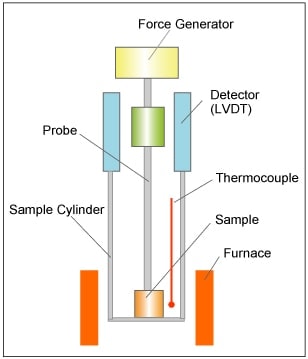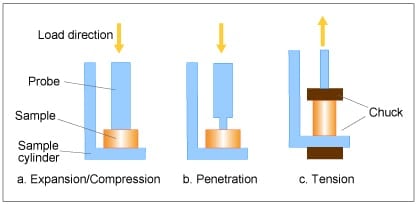Principle of Thermomechanical Analysis (TMA)
Definitions of Thermomechanical Analysis (TMA)
A technique in which a deformation of the sample under non-oscillating stress is monitored against time or temperature while the temperature of the sample, in a specified atmosphere, is programmed. The stress may be compression, tension, flexure or torsion.
* This is definition of TG by ICTAC.
Description of TMA

Figure1 shows the Block Diagram of a TMA.
The sample is inserted into the furnace and is touched by the probe which is connected with the Length Detector and the Force Generator. The thermocouple for temperature measurement is located near the sample.
The sample temperature is changed in the furnace by applying the force onto the sample from the Force Generator via probe.
The sample deformation such as Thermal Expansion and Softening with changing temperature is measured as the probe displacement by the Length Detector. Linear Variable Differential Transformer (LVDT) is used for Length Detection sensor.
There are several types of the probe for TMA. The choice is dependent on the measurement purpose.

(a) Expansion/Compression Probe:
It is used for the measurement of the deformation by the thermal expansion and the transition of the sample under the compressed force is applied.
(b) Penetration Probe:
It is used for the measurement of the softening temperature.
(c) Tension Probe:
It is used for the measurement of the thermal expansion and the thermal shrinkage of the sample such as the film and the fiber.
The materials of probes are quartz glass, alumina, and metals. The choice is dependent on the temperature range and/or the measurement purpose.
In case of the TMA which enables the dynamic force control on top of the static force control, the measurement of the Stress-Strain, the Creep, the stress relaxation, and the DMA measurements can be performed.
